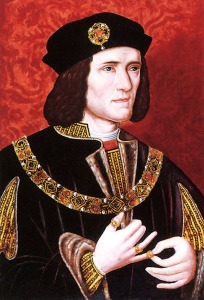
Portrait of Richard III
Richard III’s Back! – What is Scoliosis?
You may have been interested recently in the exciting discovery of Richard III‘s remains in a Leicester car park. The excavation was initiated and financed by The Richard III Society, who believe that the last Plantagenet King was wrongly vilified as a murderous despot and was, in fact, a good and popular king.
One of the stereotypes attached to the king was that he was a deformed hunchback with a withered arm and hobbling gait. The recent discovery of his bones has at least settled that conundrum – he had no withered arm and he was not a hunchback in the common perception of the word, like Quasimodo, the hunchback of Notre Dame, whose type of deformity is kyphosis (below right).

However, he did indeed have a spinal deformity, known as scoliosis (above left), an S-shaped sideways curvature of the spine. But what would that mean as regards his appearance and gait? A scoliosis is quite a common spinal deformity, although the severity varies considerably. In fact, I myself have a mild scoliosis, caused by the spine’s natural compensation for a leg length discrepancy. It is so mild that it is barely noticeable, even without clothes (unless you’re an osteopath!) Your spine compensates in order to ensure your eyes are as level as possible – so one hip might be higher, the opposite shoulder, but the head will then be level.
Scoliosis can also be present at birth (congenital). Many people who have this degree of scoliosis are probably oblivious to it and it wouldn’t affect their gait or appearance much at all.
However, some types of scoliosis can be much more severe, impinging on the symmetry of the ribcage and even interfering with breathing. This type occurs more commonly in females and often begins in puberty when the body is going through a rapid growth spurt, but the complete cause is unknown. Richard appears to have had this type of scoliosis.
What would he have looked like? Because the curve in the spine was quite severe, it is likely that Richard would have held one shoulder higher than the other and one shoulder blade would be more prominent. One hip may also have been slightly higher than the other. His ribcage would also have been more prominent on one side than the other, but when clothed this would not have been obvious. This would show more on forward bending, when the more prominent side would be exaggerated.
Do you have a scoliosis? If you suspect you might, pay a visit to your osteopath and they will be able to tell you and give you advice. If you already know you have a scoliosis you can get advice and support from The British Scoliosis Society
NB:Drawing of spine with scoliosis and kyphosis
Image credit: hfsimaging / 123RF Stock Photo




